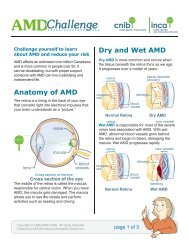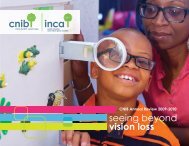Quality of Life in Age-Related Macular Degeneration - CNIB
Quality of Life in Age-Related Macular Degeneration - CNIB
Quality of Life in Age-Related Macular Degeneration - CNIB
Create successful ePaper yourself
Turn your PDF publications into a flip-book with our unique Google optimized e-Paper software.
time because they were carers or because they wanted to see their<br />
grandchildren grow up. Nevertheless, it is likely that improvement <strong>in</strong> their MD<br />
would improve their QoL. There was no relationship between utility values and<br />
vision status (registration as bl<strong>in</strong>d, partially sighted or not registered) whereas,<br />
<strong>in</strong> the same study, vision status was significantly associated with MacDQoL<br />
scores. Another UK study 64 demonstrated that 50% <strong>of</strong> participants with<br />
vary<strong>in</strong>g severity <strong>of</strong> MD were not prepared to trade any time for perfect vision<br />
and, after remov<strong>in</strong>g scores where no time was traded, there was no<br />
relationship between TTO utility values and VA. It is likely that the questions<br />
posed <strong>in</strong> the TTO method would be particularly difficult for elderly people to<br />
answer given their shorter life expectancies. The comparability <strong>of</strong> TTO<br />
responses to questions about ‘perfect health’ and those referr<strong>in</strong>g to ‘perfect<br />
vision’ must also be questioned. A person with poor vision and poor general<br />
health might view th<strong>in</strong>gs differently from a person who has poor vision but<br />
otherwise good health.<br />
Op<strong>in</strong>ions differ as to whether utility values should be obta<strong>in</strong>ed from patients,<br />
health pr<strong>of</strong>essionals or the taxpay<strong>in</strong>g general public 51 . Generally, the public<br />
overestimate the impact <strong>of</strong> medical conditions on QoL compared with<br />
patients 9 . However it has been shown that MD is an exception to this rule:<br />
both the public and health pr<strong>of</strong>essionals report higher utility values for MD<br />
than do patients 60 . This perhaps reflects an underestimation <strong>of</strong> the impact <strong>of</strong><br />
the loss <strong>of</strong> central vision and an overestimation <strong>of</strong> the value <strong>of</strong> peripheral<br />
vision. Whatever the reason, a comparison <strong>of</strong> utility values across diseases<br />
when the utilities have been obta<strong>in</strong>ed from the public would mitigate aga<strong>in</strong>st<br />
resources be<strong>in</strong>g allocated for treatment and rehabilitation <strong>of</strong> people who have<br />
MD.<br />
18











